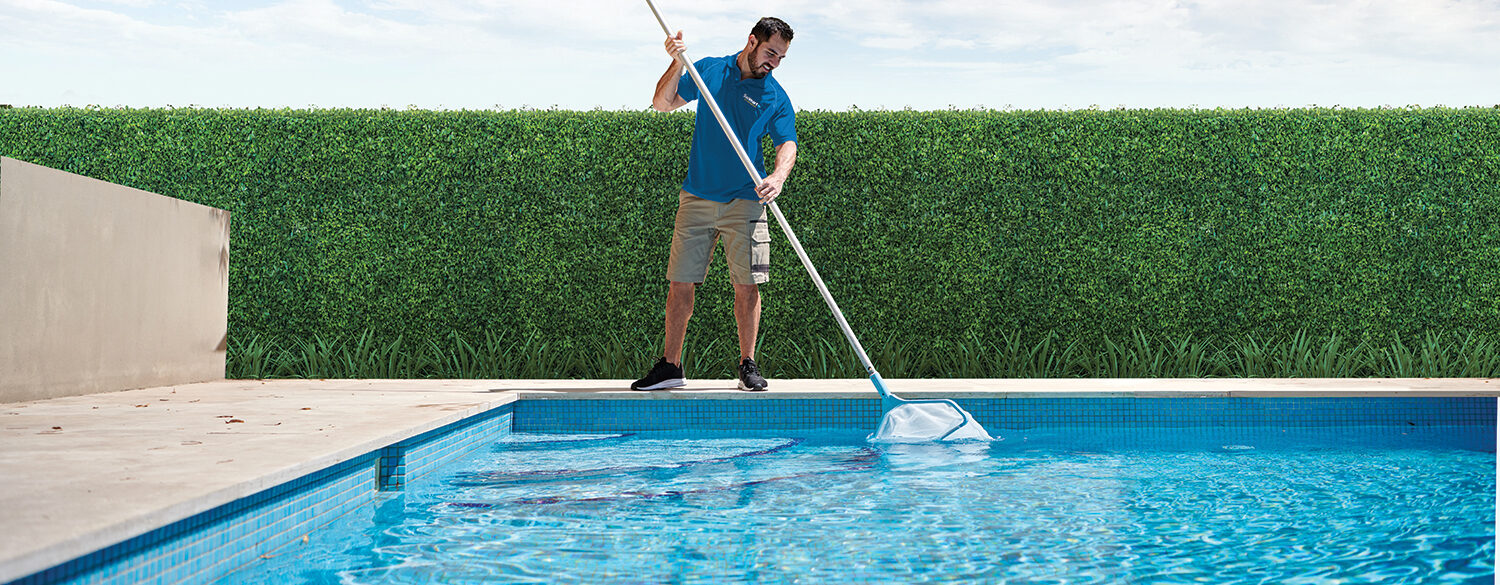Here’s how to create a thriving poolside garden with hardy plants that can cope with lots of sun and heat and occasional sprays of chlorine and salt.
A lush, tropical poolside garden
With their dense, rich-green foliage and large flowers, tropical plants create a cool, inviting and private garden while their good tolerance to heat and humidity makes them well suited to the poolside habitat.
As many tropical plants that hail from the tropics, they don’t survive in cool, dry and frost-prone regions. “For tropical plants to thrive in your poolside garden, you need to live on or near the coast where there’s a moderate, subtropical or tropical climate,” says horticulturist Colin Green of Colin Green Landscaping on Sydney’s Northern Beaches.
Another consideration when creating a tropical poolside garden is the amount of sunlight your pool area receives as this determines whether you buy sun hardy or shade-loving tropical species.
“Sun hardy tropical plant varieties include Strelitzia, also known as Bird of Paradise, Hibiscus and Canna Lily, which have red and orange flowers, and New Zealand Flax, which has green and purple-red leaves,” says Colin. According to the ABC’s Gardening Australia, Frangipanis also like plenty of sun and cope well in fertile, sandy soils.
“Shade loving varieties include Ferns, Cordylines and Rhoeo, which both have green and hot pink leaves, Alterantha which has delicate purple-green leaves, Clivea which produces clusters of orange flowers, Agapanthus, and the smaller varieties of palm including Parlour Kentia and Golden Cane,” says Colin. “Before making any final decisions on plant species however, ask your local nursery which ones will thrive in your area.”
To create a tropical poolside garden:
- Position plants closely together to create a dense garden
- Use the plants’ differing heights, foliage colours and shapes to create depth and through variety, an interplay of dark and light
- Add clusters of small species such as succulents to the front of your garden and plant taller varieties such as Hibiscus, behind
- Reduce the number of bees by adding colour with colourful leaves rather than flowers (Cordylines and Rhoeo both have pink hues in their leaves)
- Create shade with taller species, such as Palms and Frangipani, but plant them a distance away from the pool and check with your local council regulations relating to plant positioning near pools. If tall plants are too close to the fence, children can use them to climb into the pool area
- Complete your garden with a tropical-look edging that will help keep the soil out of the pool and pool wash out of the garden beds such as natural Bamboo Edging from Bunnings, as well as glazed and carved pots, a Balinese style teak bench and UV-resistant wicker sun lounges or day bed
Native poolside gardens
Many native species cope well in the poolside habitat as they are hardy, low shedding, evergreen and attract native birds. “Natives cope with lots of sun and heat and require little watering and care,” Colin explains.
As with planning any garden, Colin recommends asking your local nursery for advice on natives that will thrive in your area. “Depending on where you live, hardy natives suitable for poolside planting include grasses Philotheca myoporoides, also called Long-leaf Waxflower which has small white flowers; Acacia Fimbriata Dwarf, which has clusters of yellow blooms; Westringia fruiticosa or native rosemary which has delicate white flowers; Kangaroo Paw; and small varieties of Banksia and Grevillea such as Grevillea speciose and Grevillea sericea.”
To create a native poolside garden:
- Position smaller varieties such as native grasses in the front of your garden and taller species such as Banksia, Waratah and Bottlebrush behind
- Combine different leaf hues, colours and shapes within the garden to create texture and visual interest
- Add colour with flowering species such as Kangaroo Paw, Banksia and Grevillea speciose and Grevillea sericea, which has delicate spider-like flowers
Some non-native species that can cope well in poolside gardens include Lamb’s Ears, which creates good ground cover with its silvery leaves that are literally as soft as a lamb’s ear, Conebush which has red/orange leaves, Pittosporus golfball and Raphiolepis indica, also known as Indian Hawthorn, which grow into thick hedges.
And to help keep soil and fallen foliage contained and pool wash water out, add a natural durable timber edging such as Rola Pak Ezy Edge Garden Edging from Bunnings, which is made from rot-resistant treated pine.
A modern formal garden
Get your clippers and tape measure ready because balance, order, straight lines, hedges and topiary plants are key signatures of the modern formal garden.
Colin advises to visit your local nursery to discover species that will suit this look and thrive in your area. “For those who live in coastal regions with a moderate climate, your plant list can include: Gardenia; Camellia sasanqua; Clivia; Liriope; Agapanthus; Buxus; Lilly Pilly; Dwarf Conifer; New Zealand Flax; Yucca; hardy, quick growing Hawthorns such as Raphiolepis Apple Blossom and Raphiolepis Snow Maidens and succulents like Agave,” says Colin.
Regardless of where you live and the species of plants that suit your region’s climate, it’s their positioning and clipping that are key to creating the modern formal look.
Frame your pool with a modern formal garden by:
- Adhering to the old saying ‘less is more’ when deciding on the number of plants. Many formal gardens are created with only a few different species
- Positioning plants in structured straight lines, with small varieties at the front of the garden, medium in the middle and tall at the back
- Creating repetitive patterns of plants by alternating one species with two or three different species
- Defining areas with hedges. Hedges typically border garden beds and paths which you can create with Buxus, Lilly Pilly, Native Rosemary and Viburnum
- Placing two or four, to achieve balance and symmetry, individual potted topiary trees within the pool enclosure, perhaps in each corner of the pool enclosure, midway on either side of the pool or at each side of the gate inside the pool enclosure. Species for topiary include Pittosporus golfball, Lilly Pilly, Camellia sasanqua, Buxus, Cumquat, Azalea and Laurus nobilis
- Choosing planter boxes and pots in terrazzo look, stone or faux stone as this style has its roots in the gardens of grand English country homes and Italian palazzos
Whatever poolside garden style you choose, keep it healthy with regular watering and enjoy its beauty at night-time too with the addition of some soft pool and garden lights.
Essential tips for keeping your poolside garden healthy
Water more often
While most swimmers welcome the sun taking the chill off the water, for plants the sun’s heat, often intensified by surrounding pavers, glass fence panels and water surface reflections, can stress them by drying out soil and burning foliage. Regular watering, particular in the hotter and drier months, will help your plants stay healthy by rehydrating them and washing away any pool water chemical and salt residue. Just remember to avoid watering during the hottest part of the day.
Choose plants that suit your local climate
Not all plants thrive and survive in every region of Australia. “Most nurseries only stock plants that suit the local area, so visit your nursery to get some advice on what to buy,” advises Colin.
Choose hardy, sun and heat tolerant plants
If your pool area receives full sun for most of the day, choose species that cope well with lots of sunshine and heat, especially if you have a saltwater pool. Australian natives and varieties that grow in coastal areas have good tolerance to dry and salty conditions.
Choose low or non-shedding plants
To reduce time spent cleaning your pool and unclogging the filter box, choose evergreen species or those with minimal leaf drop. Plants species to avoid include acacia, azalea and bougainvillea. Low shedding plants include Palms, native and ornamental Grasses, Ornamental Ginger, native Rosemary and Buxus.
Avoid plants with robust root systems
Strong, extensive and/or shallow root systems can damage underground pool filter and heating pipes, and lift and crack pavers and decking. Species renowned for their invasive, destructive roots include Umbrella Tree, Rubber Tree, Ficus, and many varieties of Bamboo.
Avoid thorny plants
Swimmers and spikes are a dangerous mix! “My advice is to stay away from thorny species like Bougainvillea, as swimmers can receive cuts and their blooms often end up in the pool,” says Colin.
Take care with fertilisers, pesticides and herbicides
Residue from fertilisers, pesticides and herbicides can end up in your pool water, affecting swimmer’s health and water quality. To avoid contaminating your pool water, choose plants that require little-to-no treatments, or contain contaminants by creating a poolside garden in planter boxes and pots. You can also add edging to your garden beds using Matrix Edging from Bunnings, which has durable, plastic interlocking panels to reduce residue run off.
No bees please
Perfumed flowers attract bees, which, dead or alive can sting swimmers. Jasmine, wisteria and murraya may have pretty flowers but their sweet scents lure bees. Another good reason to avoid flowering plants is that some petals can stain pavers, decking and pool surfaces and make them slippery. “When it comes to poolside gardens, add colour with leaves rather than flowers,” advises Colin.


 AUS
AUS NZ
NZ 


